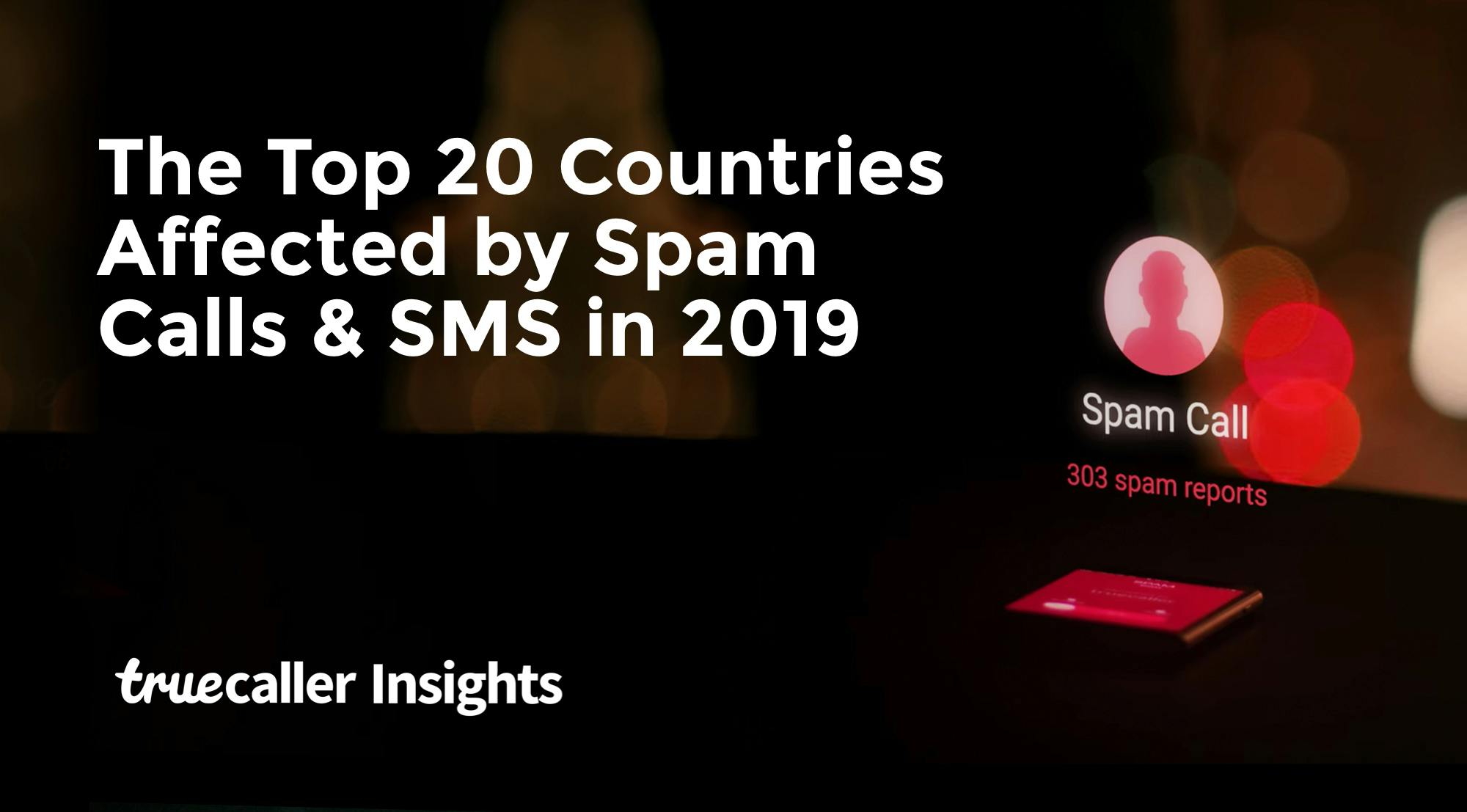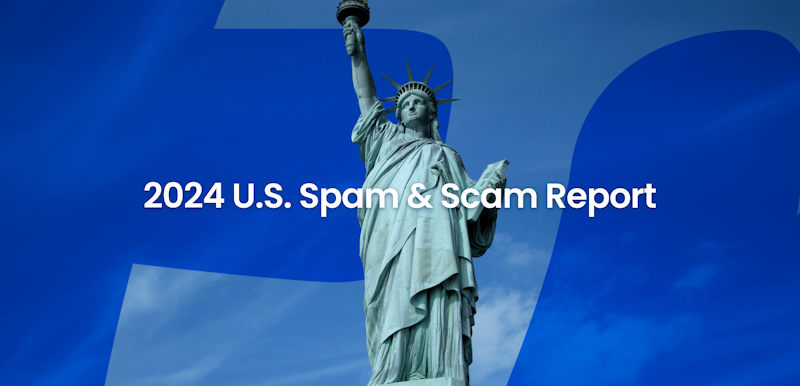
Truecaller Insights: Top 20 Countries Affected by Spam Calls & SMS in 2019
Kim Fai Kok
Dec 3, 201911 min read
Two years ago, we released our first to understand the impact of spam calls around the world. With our third edition of the report, we can see a significant shift in which countries that get the most spam calls, and it is clear that this problem is not slowing down, at all.
What is new in this year’s report is that we havetaken a look at the trend of spam SMS around the world and been able to pinpointthe top 20 countries that receives the most spam SMS.
Why is this happening?
The phone has almost become anextended part of our body, and we use it to communicate with the rest of theworld. The frightening part is we’re always accessible because of it, and thisis something that spammers and scammers take advantage of.
In 2019 we have been able to help ourusers block andidentify 26 billion spam calls, which is an increase of 18% compared tolast year. Furthermore, we have helped identify 116 billion unknown calls,which is a 56% increase compared to last year.
As revealed in last year’s report, Brazil overtook India as the most spammed country inthe world, and this year’s data shows that Brazil is still on top. As a matterof fact, spam calls have been increasing for Brazilians ever since.
What are the trends we are seeing?
- Spam calls in Latin America have been increasingdramatically over the years. This year, the trend is even more clear. The countriesthat are seeing the biggest increase of spam calls are in Latin America. 5 outof the top 10 most affected markets are in that region.
- Peru has seen a significant increase of spam calls.Users are now getting on average 30.9 spam calls a month, making Peru the 2most spammed country in the world.
- The biggest increase of total spam calls comes fromIndonesia. Last year Indonesia was ranked 16, and this year themarket jumped up to 3 place, which makes it the biggest jump wehave seen.
- The country that has witnessed the biggest increase ofspam calls in percentage is Lebanon. Users in the market have seen an increaseof spam calls going from 2.8 average spam calls/user to 8.6 – that is a 208%increase in a year.
- Although India has dropped to the 5 place(India used to be the top spammed country in the world,) spam calls have beenincreasing by 15% over the year. Another devastating fact we found during thisyear is that 1 out of 3 women in India receive sexual harassment or inappropriate calls and SMS on a regular basis.
- The U.S. continues to be in the top 10 list of the most spammed countries in the world. The market saw a 7% increase of spam calls compared to last year, where it actually was decreasing. Earlier this year we conducted a study in the U.S. and found that phone scams caused Americans to lose 10.5 billion dollars in 2018, and nearly 1 in every 6 American adults falls victim to scam calls.
- New markets to enter our list: UAE, Australia, SriLanka, Malaysia, Lebanon, Nigeria and Egypt.
- Telco/operators are still the biggest spammers in theworld, and scam calls are on the rise globally.
- Who are the top 5 markets to receive the most scamcalls in the world? Malaysia (63%), Australia (60%), Lebanon (49%), Canada(48%), South Africa (39%).
Who receivesthe most spam SMS in the world?
Our data shows that the top countries that receives the most spam SMS arein the emerging markets. The top three markets that are affected are in theAfrican continent. Ethiopians receives the most spam SMS in the world, with theaverage of 119 spam SMS on a monthly basis.
In totalTruecaller helped identify 8.6 billion spam SMS globally.
Who are the topspam callers?
1. Brazil:
As spam calls continue to increase in Brazil, we tooka deeper look at who the top spammers are in the country.
Almost every other spam call in Brazil is being madefrom the operators and Internet service providers. In the past 12 months, callsfrom the operators have increased from 32% to 48%. These calls are typicallyseeking to provide special offers and upselling data plans amongst otherservices.
Scam calls continue to be a big problem in Brazil. Twoyears ago, only 1% of all the top spammers were scam related, last year it wentup to 20% – and this year it is up to 26%. One of the most common scams is the one ring scam Anunknown number (usually an international number) gives you a missed call andwhen you call back you are charged a hefty fee for calling that number. Anothercommon scam call is the fake kidnap call where someone calls andpretends they will kidnap/have kidnapped someone from your family, and want youto buy them airtime or wire money.
In 2019, calls from financial service (13%) have beenmaking a lot of calls to our users trying to upsell credit cards and loans.
2. Peru:
One of the more interesting findings in this year’s report is that Peru has second highest percentage of spam calls in the world.
As the graphshows, 1 in every 3 spam call in Peru is made by financial services that arelooking to upsell credit cards and loans. A big chunk of the top spam callsthat are terrorizing our users are from operators (24%) and outsourcedtelemarketing firms (26%) that promotes various offerings. Scam calls are alsoa big issue in Peru, where 1 out of 10 calls are scam related.
3. Indonesia:
Not only does Indonesia continue to be the most spammed market in the South East Asia region, it has become the 3 most spammed country in the world. Users are now receiving 27.9 spam calls per month.
Calls from banks, financial services and insurance brokers continue to be the top spammers in Indonesia.
The most alarmingtrend is that scam calls has more than doubled in the past year – going from10% to 21%. In the recent months there has been a lot of unrest in the country,and we have received a lot of feedback from our users that scammers use thisopportunity to scam people.
One of the more common scams is the ‘Another scam that has been going on lately is the fake hospital/injury call where someone would call and tell you that a family member or a friend is hospitalized and need immediate treatment, and you need to send them money in order for them to treat the patient.
4. Mexico:
Similar to Peru, Mexico receives many calls fromfinancial services (41%.) The biggest trend we see this year is that callsbeing made from debt collectors, both authentic and fake, have seen a massiveincrease (31%). Compared to last year, these types of calls were not in the topspam list.
Scam related calls continue to be a big problem in Mexico (10%.) There are many prisons in Mexico that are well known in making a lot of fake kidnap calls to people.
In the past 2 years, India hasdropped from being the country to receive the most spam calls in the world tothe 5th position. But this does not mean spam calls are slowing down. On thecontrary! Spam calls have been increasing with 15% in 2019.
Operators are well known to bevicious when it comes to spamming their customers. However, with the rise ofmobile payments and a growing middle class in India, we have seen banks,fin-tech companies, and outsourced telemarketing services emerging as bigspammers.
6. South Africa:
Scam calls continues to be a big threat for consumers in South Africa (39%).The most common scams are:
- Techsupport fraud, where someone pretends to call from your bank or acompany saying that your account has been hijacked and needs your help to takecontrol of it.
- One ringscam, an unknown number (usually an international number)gives you a missed call and when you call them back you get charged a hefty feefor calling to that number.
- someone pretends to be a headhunter calling you tooffer you a job but you need to pay a fee in order to get the job.
Also, insurance related calls have seen a big uptake in the country. Lately,there has been complaints about insurance companies calling people to upsellcar insurance – or scammers calling pretending that your car has been towedaway and that you need to pay a fee to get it back.
7. Chile:
Although Chile has seen a marginal decrease of spamcalls over the past 12 months, it continues to be one of the most spammedcountries in the world.
Debt collectors have been pestering consumers in Chile.A significant increase of these type of calls have grown from 25% to 72% injust a year.
Robocalls are talked about all over the U.S.,and it’s no wonder. Apart from the media reporting and people complaining aboutthis issue, we have seen a clear trend in our own data showing robocallsincreasing dramatically. Comparing with last year, the number of robocalls hasincreased from 7% to a staggering 35% – which means that.
Earlier this year we also found that 43 million Americans were scammedover the phone – and 10.5 billion USD was lost to scammers in 2018. Read morehere: https://truecaller.blog/2019/04/17/truecaller-insights-2019-us-spam-phone-scam-report/.Our data further shows that close to every third spam (32%) call you get is offraudulent nature in the U.S.
Russia has moved up from the 17 most spammed country in theworld to 9 place this year. The biggest spammers in Russia arefrom banks and financial services.
Another big trend is scam calls are a big portion of all the top spam callsin Russia. We have seen a pattern that scams calls have been tagged ascompanies/individuals pretending to call from banks trying to lure them toshare sensitive information.
Today, Colombia is the tenth most spammedcountry in the world. The majority of spam calls come from operators (39%) andfinancial services (29%,) followed by a big chunk of scam calls (22%.) In ourdata, we can see many of these fraudulent calls are ‘insurance related’ –meaning someone pretending to be from an insurance company and wanting to signyou up for something and charge you.
Also, Bogota has been ranked as the world’sworst city for sexual harassment (source: Plan International) – and during the past twoyears we have been receiving a lot of feedback from women saying thatharassment calls has worsened in the country.
Ever since westarted to track the spam behavior in Canada, scam calls have been skyrocketing.Fake debt collector calls are one lethal scam that has hit our users.
We have also seena lot of market research and political calls being made to people.
12. UAE:
The UAE has surfaced as another top spamming countryin the past 12 months. The dominating spammer in the region are the operatorswho often are looking to upsell plans.
We have also seen that there has been a lot of fraudulentcalls that is related to visa scams. Basically, what this entails isthat these scammers pretend to give people a visa (specifically to Canada) andwant money in return.
13. Italy:
Telemarketingcalls from energy and television providers (47%) continues to be the biggestspammers in Italy. The operators also account for a big portion of thespammers.
In the past12 months, scam calls seem to have increased from 9% to 16%. Last year therewere a lot of reporting that scammers were targeting customers of TIM, WindTre, and Vodafone. The scammers simply call up people with a very well thoughtout script to lure their victim to say ‘yes’ to their questions, which is laterbeing cut out to be pasted to a different agreement where they seem to agree tocertain premium services
14. Australia:
Australiahas emerged as one of the most spam affected countries in the world. As thegraph indicates, scam calls are the biggest spammers in Australia. The countryhas witnessed a huge rise of international calls hitting people’s phone. One ofthe most common scam calls are:
- ‘Onering scam’ where someone gives you a missed call (often from aninternational number) and when you call back you will get charged a hefty sum.
- ‘Visascam’ where someone pretend to offer you an opportunity to get a visa inAustralia.
- ‘fraud.
Our dataalso shows that there has been an increase of telemarketing calls from ‘greenenergy’ companies.
15. Sri Lanka:
Spam calls fromoperators continues to be the dominating spammer in Sri Lanka. Two years ago,we look at the trends of top spammers in the market, and since, spam calls fromthe operators has increased from 72% to 81%.
The study canbe found here: https://truecaller.blog/2017/12/14/top-spammers-in-sri-lanka-are-telecom-operators-in-2017/
16. Israel
For the second consecutive year, Israel is in the top20 most spammed countries in the world. Israel is the only country where we seethat Political calls are the biggest spammer. Our data shows that the peopleare getting a lot of donation calls from various politicians, and sometimesthese calls can even be of fraudulent nature.
17. Lebanon:
This year spam calls have increased by 208% inLebanon, which makes it the country that has seen the biggest increase of spamcalls this year (for the top 20 countries).
Almost every other call people receive in Lebanon thatis spam related, is a potential scam call. We can see in our data that therehas been a lot of fraudulent calls on ‘visa scams’ to cheat people forvisa to Canada.
18: Nigeria:
Last year Nigeria fell off from the list, but thisyear Nigeria has once again emerged as a top spamming country in the world.
Operators continue to be the top spammer in this country,and has grown from 61% to 85% in the past two years (compared to the report from 2017).
19: Malaysia:
Analyzing this year’s data, we can see that Malaysia is the market thatreceives the biggest percentage of scam calls in the world.
Today, 63% of the top spam calls in Malaysia are of fraudulent nature. Fakeinsurance and debt collecting calls are the normal scam calls. ‘Astro’and ‘Macau’ scam has been flooding the market in the recent year. Lately,there has been scammers pretending to be calling from local post deliveryservices that a package is stuck somewhere and that they need you to pay beforethey can release it.
Over the past 12 months Malaysia has seen a 24% increase of spam calls,going from 6.7 spam calls/month to 8.3.
20: Egypt:
Egypt used to be in the top 10 list of the most spammed countries in theworld (2017), however, last year it dropped out of the top 20 list, it’s backin 2019.
The biggest spammers in Egypt are the operators and telecom serviceproviders looking toupsell various offers and balance reminders. Scam calls is also a common thingin Egypt, where almost a quarter of all spam calls are scam related.
Notes & Methodology:
The data in this article was aggregated anonymously from incoming calls that either has been marked as spam by users – or automatically been flagged by Truecaller during the period of January 1st, 2019 to October 30th, 2019 to understand the monthly average spam rate. During this period of time we helped our users identify 116 billion calls, helped identify 8.6 billion spam SMS globally.
Our previous study from 2018 can be found here; and the 2017 report can be found here.
The data in thisarticle was aggregated anonymously from incoming calls thatwere either marked as spam by users – or automatically flagged by Truecaller during the period of January 1st, 2018 to October30th, 2019 to understand the monthly average spam rate. During this period oftime, we helped our users identify 116 billion calls and 8.6 billion spam SMSglobally.
Previous reports from 2018 can be found here while the 2017 report can be found here.
Graphics can be found here.
For more stats and how Truecaller users communicated in 2019 please visit our Year in Calling site.
Category Key:
Nuisance: Due to this being a broadspectrum of calls, it is generally calls that is unwanted, disturbance forusers, harassment, pranks.
Telemarketing: Promotional callsfrom companies, surveys, political calls, new client outreach for services,subscriptions, etc.
Robo-calls are automated calls that are placed to people with a pre-recorded message. Some of these calls can sound like real people talking, and when you reply to their queries, they can be very sophisticated and use voice recognition technology to answer and ask follow-up questions.
Operator: Telecom companies upsellingdata plans, promotions, etc.
Financial service: Banks, creditunions, credit card companies etc.
Scam: Fraud attempts, moneyswindling, unknown links, etc.
Insurance: Companies that specializein selling different types of insurances.
Debt collection: Organizations that specialize in payments of debts owed by individuals or businesses,bounty hunters.
Political: Campaign calls to securevotes for parties, robocalls.
Health: Hospitals, private practices.

Kim Fai Kok
Dec 3, 201911 min read


